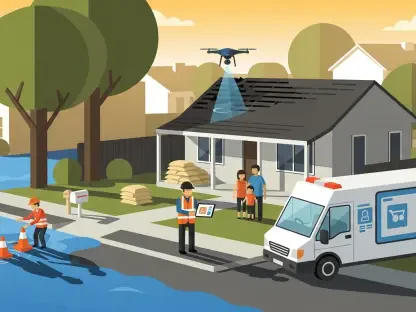Imagine navigating the labyrinthine streets of London, where narrow lanes, erratic traffic, and darting pedestrians create a daily gauntlet for even the most seasoned drivers, and into this chaos steps Waymo, the autonomous vehicle division born from Google, poised to introduce its robotaxi service to the British capital as early as spring. This pilot program, supported by the UK government, will offer limited public rides bookable through an app, with no safety driver present—a daring leap into the future of urban transport. Having already clocked over 10 million driverless trips across several American cities, Waymo brings a wealth of experience to the table. Yet, the question looms large: can technology refined in the more predictable grids of US urban centers withstand the unpredictable quirks of London’s roads? This venture represents not just a technological trial but a potential redefinition of mobility in one of the world’s most iconic cities, setting the stage for a broader global rollout.
Tackling Operational Hurdles in an Unfamiliar Terrain
Waymo’s transition from American testing grounds to the heart of London signals a significant shift from experimentation to practical deployment. The company has been actively recruiting for critical roles such as fleet readiness leads and incident response managers, indicating a focus on ensuring vehicles are operational and emergencies are handled swiftly. These efforts underscore a commitment to a seamless launch, building on the acquisition of a UK-based software firm to bolster local expertise. However, the operational landscape here is far from forgiving. Unlike the wide, structured streets of US cities where Waymo has boasted a safety record up to 91% better than human drivers, London’s tight corners, roundabouts, and inconsistent road markings pose unique challenges. Adapting sensor systems and algorithms to these conditions will be paramount, as even minor miscalculations could disrupt service or worse. The robustness of Waymo’s technology in this new environment will serve as a litmus test for its global ambitions.
Beyond the technical adjustments, managing a fleet in a foreign market introduces layers of logistical complexity for Waymo. Coordinating vehicle maintenance, responding to real-time incidents, and ensuring consistent service availability in a city known for its congestion require meticulous planning. The contrast between American urban sprawls and London’s dense, often medieval street layouts cannot be overstated—each junction and narrow passage presents a puzzle for autonomous navigation. Moreover, cultural differences in driving behavior and pedestrian interactions add another dimension of difficulty. Success in this arena will hinge on Waymo’s ability to integrate local data and refine its systems to anticipate the unexpected. If the company can navigate these operational intricacies, it could set a precedent for how autonomous vehicles adapt to diverse global cities, proving that technology can indeed transcend geographical boundaries with the right preparation.
Navigating the Regulatory Maze and Public Safety Concerns
The regulatory environment surrounding autonomous vehicles in the UK adds a critical dimension to Waymo’s London debut. The Department for Transport is diligently working toward a comprehensive national framework for driverless technology, anticipated to be finalized by 2027. In the interim, the upcoming pilot program will operate under tightly controlled conditions, allowing passengers to experience rides without a safety driver while ensuring stringent oversight. This cautious stance reflects a delicate balance between fostering innovation and protecting public welfare. The government’s approach is designed to mitigate risks in a high-stakes urban setting, where any incident could have amplified repercussions due to London’s visibility on the global stage. How these early trials are managed will likely shape the trajectory of regulatory policies not just in the UK but potentially across Europe.
Public safety remains at the forefront of this regulatory puzzle, intertwined with the challenge of building societal trust in autonomous systems. While the prospect of driverless taxis zipping through London is exciting, it also raises valid concerns among residents accustomed to human-driven transport. A single high-profile failure—be it a navigational error or a collision—could significantly dent public confidence, slowing the adoption of this technology. The government and Waymo must prioritize transparent communication about safety protocols and incident response strategies to assuage fears. Moreover, these initial deployments will serve as a real-world classroom for regulators to observe how autonomous vehicles interact with unpredictable human elements in a dense city. The lessons learned from this phase will be instrumental in refining rules and ensuring that safety remains non-negotiable as the technology scales up.
Redefining Insurance Models for a Driverless Era
The advent of Waymo’s robotaxis in London heralds a seismic shift for the motor insurance industry, which must now grapple with liability in the absence of human drivers. Traditional models, centered on assessing individual driver risk, are ill-suited for autonomous fleets where software errors or systemic failures could be the culprits. Insurers face the daunting task of reallocating responsibility, often bearing third-party claims initially before seeking recourse from manufacturers or tech providers. The potential for correlated failures—where a single glitch impacts an entire fleet—introduces unprecedented risks that could overwhelm current frameworks. Waymo’s centrally managed fleet model may necessitate a business-to-business insurance approach with higher coverage limits, pushing the industry to innovate rapidly with data-driven risk assessment tools to keep pace with this technological leap.
Compounding these challenges is the uncertainty around how quickly the insurance market can adapt to such novel risks. Detailed data logs, software versioning, and real-time map updates will be essential for determining fault and processing claims, yet establishing these systems requires collaboration across multiple sectors. There’s also speculation that tech giants like Google, Waymo’s parent entity, might explore self-insurance during these pilot stages to sidestep the high costs or slow pace of market solutions. This possibility underscores a broader gap in tailored insurance products for autonomous vehicles, particularly concerning large-scale failure scenarios. Reinsurers, too, must reconsider coverage across motor, product, and cyber domains to address these accumulation risks. The evolution of insurance in response to Waymo’s deployment will likely set benchmarks for how financial responsibility is managed in the driverless future.
Building Trust and Scaling in a High-Demand Urban Hub
Winning over the public’s trust stands as a cornerstone for Waymo’s aspirations in London, where the appetite for innovative transport solutions is matched by scrutiny over safety. The city’s dense population and constant demand for mobility present a golden commercial opportunity, ideal for testing the scalability of robotaxi services. However, this potential comes with a caveat: early deployments must be executed with near-perfect precision to avoid fueling skepticism. A misstep in such a high-profile market could ripple beyond London, impacting perceptions of autonomous technology worldwide. Both Waymo and local authorities face immense pressure to demonstrate that driverless cars can integrate seamlessly into daily life, addressing concerns through rigorous testing and clear public engagement. The outcome of these initial trials will likely determine whether London becomes a launchpad or a cautionary tale for this emerging industry.
Scaling operations in a market as demanding as London also requires a deep understanding of local dynamics, from traffic patterns to cultural attitudes toward technology. Unlike smaller test environments, this city’s sheer volume of interactions—between vehicles, pedestrians, and cyclists—amplifies the complexity of ensuring reliable service. Waymo must prove that its systems can handle peak-hour chaos and unexpected disruptions without faltering. Furthermore, fostering partnerships with local stakeholders could be key to smoothing this transition, ensuring that the technology complements rather than competes with existing transport networks. If successful, London could serve as a blueprint for other global metropolises, showcasing how autonomous vehicles can thrive in challenging urban ecosystems. The path to scalability will demand not just technical prowess but also a nuanced approach to community integration.
Reflecting on a Pioneering Moment
Looking back, Waymo’s bold move to launch robotaxi services in London marked a defining chapter in the saga of autonomous transportation. The pilot program tested the limits of technology against the backdrop of one of the world’s most intricate urban mazes, challenging preconceptions about what driverless vehicles could achieve. As the industry absorbed the lessons from those early days, the focus shifted to actionable next steps: refining algorithms for diverse environments, strengthening regulatory scaffolds, and innovating insurance solutions to match the pace of change. The journey highlighted the need for global collaboration among tech firms, policymakers, and insurers to address emerging risks and build enduring trust. Moving forward, the insights gained from this venture offered a roadmap for future deployments, emphasizing adaptability and public engagement as cornerstones of progress in reshaping urban mobility for generations to come.









